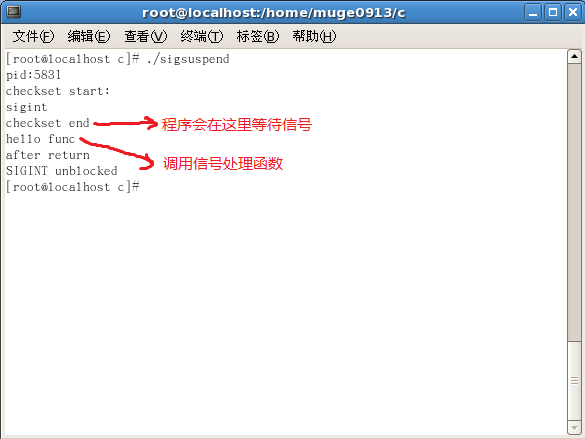函数原型:
#include <signal.h>作用:
用于在接收到某个信号之前,临时用mask替换进程的信号掩码,并暂停进程执行,直到收到信号为止。
返回值:
sigsuspend返回后将恢复调用之前的的信号掩码。信号处理函数完成后,进程将继续执行。该系统调用始终返回-1,并将errno设置为EINTR.
也就是说,sigsuspend后,进程就挂在那里,等待着开放的信号的唤醒。系统在接受到信号后,马上就把现在的信号集还原为原来的,然后调用处理函数。
如果按照sig_handler先返回,那么SIGINT是不该被打印出来的,因为那时屏蔽字还没有恢复,所有信号都是不阻塞的。那么是Stevens说错了么?当然没有,只是Stevens没有说请在sigsuspend的原子操作中到底做了什么?
sigsuspend的整个原子操作过程为:
(1) 设置新的mask阻塞当前进程;
(2) 收到信号,恢复原先mask;
(3) 调用该进程设置的信号处理函数;
(4) 待信号处理函数返回后,sigsuspend返回。

Stevens在《Unix环境高级编程》一书中是如是回答的“If a signal is caught and if the signal handler returns, then sigsuspend returns and the signal mask of the process is set to its value before the call to sigsuspend.”,由于sigsuspend是原子操作,所以这句给人的感觉就是先调用signal handler先返回,然后sigsuspend再返回。
int main(void) {
sigset_t newmask, oldmask, zeromask;
if (signal(SIGINT, sig_int) == SIG_ERR)
err_sys("signal(SIGINT) error");
sigemptyset(&zeromask);
sigemptyset(&newmask);
sigaddset(&newmask, SIGINT);
/* block SIGINT and save current signal mask */
if (sigprocmask(SIG_BLOCK, &newmask, &oldmask) < 0)
err_sys("SIG_BLOCK error");
/* critical region of code */
pr_mask("in critical region: ");
/* allow all signals and pause */
if (sigsuspend(&zeromask) != -1)
err_sys("sigsuspend error");
pr_mask("after return from sigsuspend: ");
/* reset signal mask which unblocks SIGINT */
if (sigprocmask(SIG_SETMASK, &oldmask, NULL) < 0)
err_sys("SIG_SETMASK error");
/* and continue processing ... */
exit(0);
}
static void sig_int(int signo) {
pr_mask("\nin sig_int: ");
return;
}
$a.out
in critical region: SIGINT
^C
in sig_int: SIGINT
after return from sigsuspend: SIGINT 如果按照sig_handler先返回,那么SIGINT是不该被打印出来的,因为那时屏蔽字还没有恢复,所有信号都是不阻塞的。那么是Stevens说错了么?当然没有,只是Stevens没有说请在sigsuspend的原子操作中到底做了什么?
sigsuspend的整个原子操作过程为:
(1) 设置新的mask阻塞当前进程;
(2) 收到信号,恢复原先mask;
(3) 调用该进程设置的信号处理函数;
(4) 待信号处理函数返回后,sigsuspend返回。
#include <stdio.h>
#include <signal.h>
void checkset();
void func();
void main()
{
sigset_tblockset,oldblockset,zeroset,pendmask;
printf("pid:%ld\n",(long)getpid());
signal(SIGINT,func);
sigemptyset(&blockset);
sigemptyset(&zeroset);
sigaddset(&blockset,SIGINT);
sigprocmask(SIG_SETMASK,&blockset,&oldblockset);
checkset();
sigpending(&pendmask);
if(sigismember(&pendmask,SIGINT))
printf("SIGINTpending\n");
if(sigsuspend(&zeroset)!= -1)
{
printf("sigsuspenderror\n");
exit(0);
}
printf("afterreturn\n");
sigprocmask(SIG_SETMASK,&oldblockset,NULL);
printf("SIGINTunblocked\n");
}
void checkset()
{ sigset_tset;
printf("checksetstart:\n");
if(sigprocmask(0,NULL,&set)<0)
{
printf("checksetsigprocmask error!!\n");
exit(0);
}
if(sigismember(&set,SIGINT))
printf("sigint\n");
if(sigismember(&set,SIGTSTP))
printf("sigtstp\n");
if(sigismember(&set,SIGTERM))
printf("sigterm\n");
printf("checksetend\n");
}
void func()
{
printf("hellofunc\n");
} 
父子进程同步到方法如下:
#include "apue.h"
static volatile sig_atomic_t sigflag; /* set nonzero by sig handler */
static sigset_t newmask, oldmask, zeromask;
static void
sig_usr(int signo) /* one signal handler for SIGUSR1 and SIGUSR2 */
{
sigflag = 1;
}
void
TELL_WAIT(void)
{
if (signal(SIGUSR1, sig_usr) == SIG_ERR)
err_sys("signal(SIGUSR1) error");
if (signal(SIGUSR2, sig_usr) == SIG_ERR)
err_sys("signal(SIGUSR2) error");
sigemptyset(&zeromask);
sigemptyset(&newmask);
sigaddset(&newmask, SIGUSR1);
sigaddset(&newmask, SIGUSR2);
/*
* Block SIGUSR1 and SIGUSR2, and save current signal mask.
*/
if (sigprocmask(SIG_BLOCK, &newmask, &oldmask) < 0)
err_sys("SIG_BLOCK error");
}
void
TELL_PARENT(pid_t pid)
{
kill(pid, SIGUSR2); /* tell parent we're done */
}
void
WAIT_PARENT(void)
{
while (sigflag == 0)
sigsuspend(&zeromask); /* and wait for parent */
sigflag = 0;
/*
* Reset signal mask to original value.
*/
if (sigprocmask(SIG_SETMASK, &oldmask, NULL) < 0)
err_sys("SIG_SETMASK error");
}
void
TELL_CHILD(pid_t pid)
{
kill(pid, SIGUSR1); /* tell child we're done */
}
void
WAIT_CHILD(void)
{
while (sigflag == 0)
sigsuspend(&zeromask); /* and wait for child */
sigflag = 0;
/*
* Reset signal mask to original value.
*/
if (sigprocmask(SIG_SETMASK, &oldmask, NULL) < 0)
err_sys("SIG_SETMASK error");
}




















 1391
1391

 被折叠的 条评论
为什么被折叠?
被折叠的 条评论
为什么被折叠?








